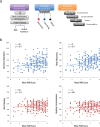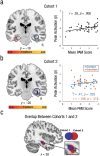Positive Attitude Toward Math Supports Early Academic Success: Behavioral Evidence and Neurocognitive Mechanisms
- PMID: 29364780
- PMCID: PMC5854512
- DOI: 10.1177/0956797617735528
Positive Attitude Toward Math Supports Early Academic Success: Behavioral Evidence and Neurocognitive Mechanisms
Abstract
Positive attitude is thought to impact academic achievement and learning in children, but little is known about its underlying neurocognitive mechanisms. Using a large behavioral sample of 240 children, we found that positive attitude toward math uniquely predicted math achievement, even after we accounted for multiple other cognitive-affective factors. We then investigated the neural mechanisms underlying the link between positive attitude and academic achievement in two independent cohorts of children (discovery cohort: n = 47; replication cohort: n = 28) and tested competing hypotheses regarding the differential roles of affective-motivational and learning-memory systems. In both cohorts, we found that positive attitude was associated with increased engagement of the hippocampal learning-memory system. Structural equation modeling further revealed that, in both cohorts, increased hippocampal activity and more frequent use of efficient memory-based strategies mediated the relation between positive attitude and higher math achievement. Our study is the first to elucidate the neurocognitive mechanisms by which positive attitude influences learning and academic achievement.
Keywords: attitudes; brain; childhood development; learning; mathematics achievement.
Conflict of interest statement
Figures



Similar articles
-
Threats and Supports to Female Students' Math Beliefs and Achievement.J Res Adolesc. 2019 Jun;29(2):449-465. doi: 10.1111/jora.12384. Epub 2018 Mar 23. J Res Adolesc. 2019. PMID: 29570890
-
Academic Achievement Deficits and Their Neuropsychological Correlates in Children Born Extremely Preterm.J Dev Behav Pediatr. 2017 Oct;38(8):627-637. doi: 10.1097/DBP.0000000000000479. J Dev Behav Pediatr. 2017. PMID: 28877090 Free PMC article.
-
Neurocognitive and Behavioral Predictors of Math Performance in Children With and Without ADHD.J Atten Disord. 2016 Feb;20(2):108-18. doi: 10.1177/1087054713504620. Epub 2013 Sep 26. J Atten Disord. 2016. PMID: 24071774 Free PMC article.
-
A longitudinal study of neuropsychological functioning and academic achievement in children with and without signs of attention-deficit/hyperactivity disorder.J Clin Exp Neuropsychol. 2014;36(6):621-35. doi: 10.1080/13803395.2014.921284. Epub 2014 Jun 2. J Clin Exp Neuropsychol. 2014. PMID: 24882447
-
On the relationship between math anxiety and math achievement in early elementary school: The role of problem solving strategies.J Exp Child Psychol. 2016 Jan;141:83-100. doi: 10.1016/j.jecp.2015.07.014. Epub 2015 Sep 2. J Exp Child Psychol. 2016. PMID: 26342473
Cited by
-
Assessing the attitude and problem-based learning in mathematics through PLS-SEM modeling.PLoS One. 2022 May 19;17(5):e0266363. doi: 10.1371/journal.pone.0266363. eCollection 2022. PLoS One. 2022. PMID: 35587507 Free PMC article.
-
Predictors of mathematical attainment trajectories across the primary-to-secondary education transition: parental factors and the home environment.R Soc Open Sci. 2020 Jul 8;7(7):200422. doi: 10.1098/rsos.200422. eCollection 2020 Jul. R Soc Open Sci. 2020. PMID: 32874637 Free PMC article.
-
Maths attitudes, school affect and teacher characteristics as predictors of maths attainment trajectories in primary and secondary education.R Soc Open Sci. 2020 Oct 7;7(10):200975. doi: 10.1098/rsos.200975. eCollection 2020 Oct. R Soc Open Sci. 2020. PMID: 33204463 Free PMC article.
-
Cognitive training enhances growth mindset in children through plasticity of cortico-striatal circuits.NPJ Sci Learn. 2022 Nov 12;7(1):30. doi: 10.1038/s41539-022-00146-7. NPJ Sci Learn. 2022. PMID: 36371438 Free PMC article.
-
Patterns of Attention and Anxiety in Predicting Arithmetic Fluency among School-Aged Children.Brain Sci. 2022 Mar 11;12(3):376. doi: 10.3390/brainsci12030376. Brain Sci. 2022. PMID: 35326332 Free PMC article.
References
-
- Achenbach T. M., Rescorla L. A. (2001). Manual for the ASEBA school-age forms and profiles. Burlington: University of Vermont Research Center for Children, Youth, and Families.
-
- Aiken L. R. (1976). Update on attitudes and other affective variables in learning mathematics. Review of Educational Research, 46, 293–311. doi:10.3102/00346543046002293 - DOI
-
- Aiken L. R., Dreger R. M. (1961). The effect of attitudes on performance in mathematics. Journal of Educational Psychology, 52(1), 19–24. doi:10.1037/h0041309 - DOI
-
- Blackwell K. L., Trzesniewski K. H., Dweck C. S. (2007). Implicit theories of intelligence predict achievement across an adolescent transition: A longitudinal study and an intervention. Child Development, 78, 246–263. - PubMed
Publication types
MeSH terms
Grants and funding
LinkOut - more resources
Full Text Sources
Other Literature Sources

